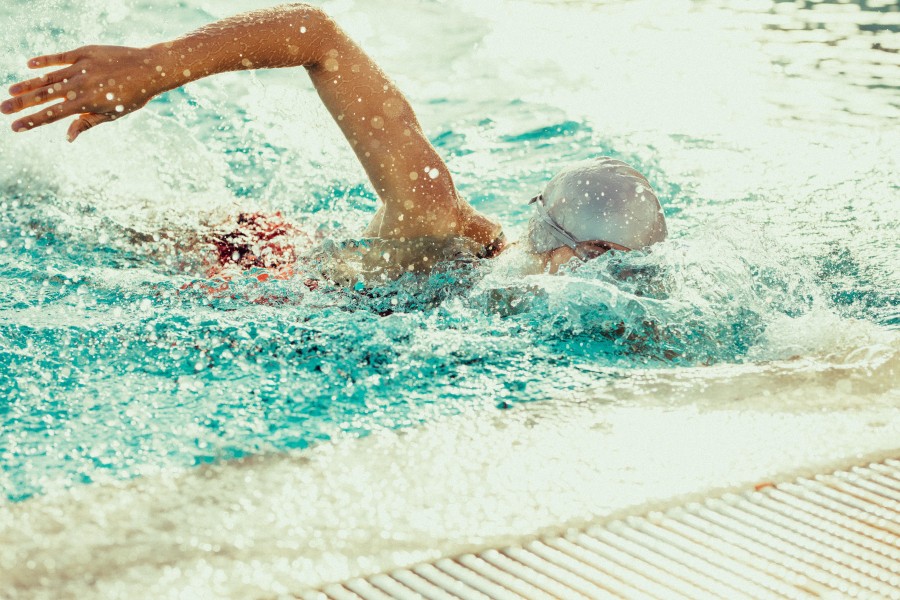Insulin pumps and swimming: what you need to know

Insulin pumps and swimming: what you need to know
If you have type 1 diabetes and use an insulin pump, or are thinking of getting one, you may want to know about the impact of the device on physical activity; let’s take a closer look at swimming.
Insulin pump therapy means wearing a portable, battery-powered device, which can continuously deliver rapid-acting insulin through a cannula into the skin, to help manage blood glucose levels. But will you be able to swim while your insulin pump is attached?
Let’s explore this and talk about what to do if you need to detach your pump for swimming, and a few other tips for swimming with diabetes.
The benefits of swimming
People with diabetes are recommended to take part in regular exercise, both for its effects on diabetes and overall health.
Swimming is a type of aerobic exercise (exercise that makes your heart beat faster and makes you breathe harder) that has been suggested for people with diabetes and can be easier on joints and the body for a more comfortable exercise experience.
Exercising regularly, such as swimming classes or sessions, has considerable health benefits for people with type 1 diabetes, such as improved cardiovascular fitness and muscle strength, as well as reduced blood glucose levels and increased insulin sensitivity.
Can you go swimming with an insulin pump?
Wearing an insulin pump doesn’t have to stop you from doing the exercises you enjoy, such as swimming.
It is possible to go swimming with a pump attached, although this very much depends on the type of pump you use. A lot of pumps will need to be fully disconnected before you get in the water, but there are some that can stay on the body. If you need to disconnect it for swimming, you will need to make sure you’re safe to swim and aware of your blood glucose levels before, during if you can, and after so that you can treat accordingly. It will be okay to disconnect your pump for a certain amount of time, but your diabetes healthcare team and pump user guide should give you individual advice depending on your pump.
As with all things diabetes, you should speak to your healthcare team if you are thinking of making changes, especially if you want information about how to safely disconnect from your pump for physical activities.
For the first few times you go swimming, it might be useful to make a note of your blood glucose levels before, during exercise and after so that you can see how swimming generally affects your levels and help to make preparation a little easier next time.
Swimming with an insulin pump

Swimming with an insulin pump
One of the most important things when deciding whether you can swim with your pump is to check any instruction manuals, user guides or get in touch with the company that made the pump to find out how it will function in water and any restrictions there might be, such as maximum depths.
Not all pumps are waterproof. The manufacturers of the pump you use will be able to advise on how water-resistant or waterproof your particular model is.
Only fully waterproof pumps are suitable for use in the water, as non-waterproof pumps can be damaged by water intake.
If you are using your insulin pump in the pool, there are a few things that you could do to make things a little easier:
-
Try planning your day, including timings of meals, snacks and insulin dosing
-
Ensure that your cannula site is securely attached and kept in place ready for being in the water
-
Sometimes the adhesive used for the infusion set can become loose in the water. You can wear a t-shirt or wetsuit top over the cannula site as well as a waterproof bandage to hold it in place
- If it is a pump with tubing, ensure that all tubing is safely secured to make sure you or anyone else doesn’t get caught in it whilst you’re swimming.
Make sure that you have discussed using the pump in the pool with your healthcare team, who will be able to advise you further.
Non-waterproof pumps and swimming: disconnecting your pump
While insulin pump therapy allows for uninterrupted, around-the-clock delivery of insulin, people disconnect for a variety of reasons, including showering, bathing and swimming.
Your healthcare team will guide you and give you training on how to stop and start your insulin pump, as well as how to disconnect from the pump.
For some people, disconnecting the pump during exercise may be appropriate, especially in view of the potential blood glucose-lowering effect of exercise.
Pumps can be disconnected for a short amount of time — such as when changing infusion sets — without any significant effect on blood glucose. However, after around 30 minutes, there are significant effects, and your blood glucose levels will start to rise as the short-acting insulin from your pump starts to wear off.
Your diabetes team will talk to you about appropriate reasons to disconnect and how to go about the process safely.
Once you have disconnected, there are a few tips to help you enjoy your swimming experience:
-
Make sure that your cannula site is well protected and stuck down ready for reconnecting your pump afterwards
-
You may need to test blood glucose regularly, including before, during and after disconnection
Be extra careful once you are disconnected and monitor yourself for high blood glucose. This can help you to avoid diabetes ketoacidosis (DKA), which can happen if there is prolonged insulin infusion interruption.
Swimming and blood glucose
Swimming when you have diabetes, as with all physical activity, is a process of learning how your body reacts to the exercise. Some people may find that swimming lowers their blood glucose levels, while for some, it may cause blood glucose to be higher than normal.
Checking your blood glucose levels before, during and after your swim can help you to understand how swimming is affecting your body.
You may find that you need to adjust the doses of your insulin on swimming days. For an insulin pump, this may involve changing the rate of your insulin infusion. This will be different for everyone, so it’s important to get advice from your healthcare team.
It’s also worth noting that when we exercise, our body needs carbohydrates for fuel, so you may need to increase your carb intake. This can include taking a carb snack before, during or after your swim, such as a cereal bar or piece of fruit.
Whenever you are swimming, you should also bring your glucose monitor and treatment for hypoglycaemia. For a long and intense session (over an hour) you may need to eat something containing carbs, such as glucose sports drinks or gels.
As with all exercise, even swimming, it is important to keep hydrated, so make sure that you drink regularly before, during and after your swim.
The effects of swimming can last after the activity itself is over — some people find that exercise increases their insulin sensitivity (how well your body uses insulin to get your blood glucose levels down). This means it is important to keep checking your levels after swimming, so that you can adjust your treatment to match.
Tips for swimming with diabetes
Swimming is a fun activity and, with a little planning, great for your health. There are a few things you can easily do to make swimming a stress-free and enjoyable experience.
Talk to your diabetes team
If you are new to swimming, consider discussing your plans with your healthcare team. This is especially true if you have particular concerns such as high or low blood glucose while you are swimming.
Take time to learn the effects of exercise on your blood glucose
Everyone is different, with differing responses to physical exertion like swimming. You may find that you need to make changes to your insulin dosing on days when you go swimming, and potentially on days after.
Look after your feet
If you have diabetes, you’re more likely to have complications with your feet. Before you get in the pool, check your feet to ensure that there are no signs of cuts, grazes or infection, and use flip-flops (or similar) around the pool to avoid injury or infection before getting in the water.
You should also check your feet after swimming. If you notice something isn’t healing properly, be sure to speak to your healthcare team for further advice.
Look after your tech
While we have spoken about ensuring that your insulin pump is waterproof, you may find that other technology you use to manage your diabetes is not. These can include continuous glucose monitors (CGM), flash glucose monitors and other sensors. Every model is different, so it is important to check. Any non-waterproof devices should be protected when around the pool to avoid damage.
You should ensure that insulin is stored at the appropriate temperature (so out of the sun if you are outside).
Swimming is an activity that can be both fun and great for your health. With a little planning, swimming when you use an insulin pump is possible.
Your healthcare team will be able to support you if you have any questions either about pump use, or how to integrate exercise into your daily life.
Sources
- Richardson, E.A. Insulin pump therapy: A guide for non-specialist staff. Journal of Diabetes Nursing. 2019;23(01): 1-7.
- Colberg, S.R., Sigal, R.J., Yardley, J.E., Riddell, M.C., Dunstan, D.W., Dempsey, P.C., Horton, E.S., Castorino, K, Tate, D.F. Physical Activity/Exercise and Diabetes: A Position Statement of the American Diabetes Association. Diabetes Care 2016; 39 (11): 2065–2079.
- National Institute of Diabtes and Digestive and Kidney Diseases (NIDDK). Diabetes diet, eating, and physical activity. Available at https://www.niddk.nih.gov/health-information/diabetes/overview/diet-eating-physical-activity. Accessed May 2022.
- Sideravičiūtė, S. et al. The effect of long-term swimming program on glycemia control in 14–19-year aged healthy girls and girls with type 1 diabetes mellitus. Medicina (Kaunas) 2006; 42(6): 513-517.
- Alsairafi, Z.K. et al. A qualitative study exploring patients’ experiences regarding insulin pump use. Saudi Pharmaceutical Journal. 2018; 26(4): 487-495.
- Diabetes UK & Swim England. Diabetes and Competitive swimming. Accessed May 2022. Available at: https://www.swimming.org/library/documents/4235/download.
- Daniels, P. Swimming whilst wearing an insulin pump. Michigan State University. Accessed May 2022. Available at: https://www.canr.msu.edu/news/swimming_while_wearing_an_insulin_pump.
- Diabetes UK. Swimming when you have diabetes. Accessed May 2022. Available at: https://www.diabetes.org.uk/guide-to-diabetes/managing-your-diabetes/exercise/swimming-diabetes
- Zisser, H. Quantifying the Impact of a Short-Interval Interruption of Insulin-Pump Infusion Sets on Glycemic Excursions. Diabetes Care. 2008; 31 (2): 238–239. https://doi.org/10.2337/dc07-1757
- Aleppo, G. Insulin pump: what to know before you disconnect. EndocrineWeb. Accessed May 2022. Available at: https://www.endocrineweb.com/guides/how-disconnect-pump-plus-tips-traveling-pump-using-pump-school





